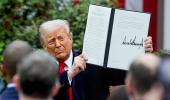'The April 9 announcement of slapping a 125% tariff on Chinese goods has brought the focus back to China, making this new phase feel like a repeat of the original conflict.'

February 2025. Donald Trump threatened to impose 10% tariff on imports from all the countries including China.
Then the Trump administration imposed 20% tariffs on China, and in retaliation, the Chinese government imposed 15% tariffs on the United States.
The first trade war between the US and China was in 2018 when Trump was the US president.
In 2025, the trade war initially was not just against China but against the entire world including countries like Vietnam, Cambodia and Thailand. Vietnam and Cambodia have been hit by some of the highest tariffs: 46% and 49%. Further down are Thailand (36%), Indonesia (32%) and Malaysia (24%). The Philippines gets a tariff of 17%, and Singapore of 10%.
And it is 26% on India.
But it all changed on the 9th of April when Trump increased the tariff on China to 125% and paused the tariffs initiated against 75 countries.
China did not remain silent. It announced a retaliatory tariff of 85% against US imports.
On April 10, Trump said, it was not 125% tariff on Chinese imports to the US but 145%.
The trade war continues...
"Like in 2018, it is clear that China is the central target again. While the initial impression was a global tariff offensive, Trump's 145% tariff on Chinese goods reveals a renewed focus on China, echoing the first US-China trade war," Ajay Srivastava, founder of the Global Trade Research Initiative, tells Rediff's Shobha Warrier.
The first of a two-part interview:
There is mayhem in all the stock markets, from the US to all the Asian countries like Japan, South Korea, India.
Trade experts and economists warn Trump about an impending economic disaster.
Do you see an imminent self-inflicted global recession happening?
We are seeing a big wave of resistance within the US with thousands of people on the streets protesting against what Trump is doing, and opposing the tariffs imposed by him. This has never happened before.
Now, you have to pay tariffs on all the components and engines imported from China or any other country. And people of the US feel that in an inter-connected world, tariffs are not going to help anyone.
Today, if you want to make something, you have to source components from all over the world.
What will happen now is, goods will become expensive in the US, and it will hurt only their consumers.
It will also hurt their exports.
Since the US is the biggest consumer of the world, this will cause inflation.
When inflation goes up, they have to increase interest rates.
When they increase interest rates, the global capital, which is deployed in most other countries including India, will travel back to the US.
When capital goes back to the US, the economy of most countries will be affected.
In short, these tariffs are going to cause low economic activities which means cutting of jobs, reducing salaries, cutting of production and less consumption.
This will ultimately result in less economic activities in some countries, inflation and depression in some others, recession in most countries.
The only ray of light I see is, with the way many countries and even the people within the US are opposing Trump, he may not be able to carry on what he is doing for long.
We hope within a few months, the world can be saved from all these negative consequences.
America is the biggest economy and the biggest market in the world.
But if the rest of the world including China, EU, the UK, etc come together, won't they be able to counter what Trump is doing?
The problem is, they are not talking to each other. Even if they talk, they talk in a weak fashion.
On the other hand, they are talking to the US at the individual level.
For example, the EU has offered zero-for-zero deal on industrial goods with the US. But Trump rejected it.
In fact, we hear that around 50 other countries are offering similar deals to the US.
I feel a zero-for-zero deal on industrial goods will be good for India.
So, countries are not talking to each other, but they are talking bilaterally with the US. This will not give them a good bargaining position.
They should talk after coming together on a single platform.
Right now, nobody has the courage to come on such a platform against the US.

Only China is standing firm against the US, talking about retaliatory tariffs...
China is fighting almost a lone battle, and it is very firm in its approach in words and deals.
When the US imposed tariffs, they counter imposed.
That's the way sovereign countries should behave.
Every country should behave like equals.
I am very happy about the way China responds.
Whatever China produces is much more than what its domestic market needs. And America is the single largest market in the world.
Can China tide over the situation by concentrating on other markets like the EU, the UK, etc?
We have to understand that people want Chinese goods. They pay for Chinese goods.
China doesn't dump goods in any country, they are paid for it.
The US imposing 125% tariff on Chinese goods should hurt China, but the US needs those goods. And they have been buying those goods.
When Trump first slapped tariffs on China, Chinese goods started reaching China via Mexico and Vietnam with which the US had free trade agreements.
This time also, similar re-routing will happen in a bigger and complex way.
Materials like small electronic items, copper wires and many such things without which the US industry will not function, and they have been coming from China.
So, what will the US do now?
China has absolute monopoly over some critical metals like solar cells. Nobody in the world makes poly silicon needed for making solar cells except China. More than 90% is made in China.
Poly silicon is a key material needed in the semi-conductor industry.
China has many such critical minerals. It processes more than 70% of the minerals consumed by the world. Everything has to go to China for processing. So, China has a lot of control over critical minerals.
Trade war or not, countries will need them and without them, economic activities will go down.
So, unless the US starts its own manufacturing, it has to buy many things because people need machinery, phones, textiles, etc.
There is no way the US can manufacture these things because the cost of production is very high there. Their hourly wages are so high that it will not justify the prices which will more than double.

You spoke about a re-routing of goods happening in a bigger and complex way. What is the new route by which the Chinese goods will reach US markets?
What will happen now is, semi-finished goods will be produced in China, and they will flow to those countries where tariffs are low. For example, the EU, Brazil or India.
These semi-finished goods will be finished in these countries and then they will reach the US market.
It is only 10% tariffs for the UK...
The UK is a developed country and the wages are high there. So, the semi-finihsed goods will not go to the UK.
It may go to Mexico in a big way. Electronic goods may go to certain ASEAN countries like Singapore where the tariff is zero. Some parts may come to India.
Even Vietnam with 50% tariffs is better than China. So, it will go from Vietnam to the US.
Tariff are like water, it flows from high level to low level. Likewise, goods will flow from high tariff countries to low tariff countries.
But the core point is, China is the biggest producer in the world, and it will keep on producing goods up to the penultimate stage.
 IMAGE: Ajay Srivastava
IMAGE: Ajay SrivastavaBut consumers in the US will have to pay for the tariffs imposed by their president...
Yes, they will have to pay higher prices.
Trump says he is doing all this to increase manufacturing and jobs.
Industrial goods account for 70% to 80% of global trade. But the US is not there.
Their wages don't justify in the production of textiles, machinery, electronics, etc. So, they keep on buying from other countries, mostly from China and Chinese goods coming from other countries.
So, the tariffs will not liberate the US from China though Trump called it 'Liberation day'..!
I think the results of this trade war will be worse than the first trade war.
While the first trade war, from 2018 to 2023, was clearly between the US and China, the second trade war, which started in January 2025, initially appeared to target the rest of the world.
However, the April 9 announcement of slapping a 125% tariff on Chinese goods while lowering tariffs to 10% for others, has brought the focus back to China, making this new phase feel like a repeat of the original conflict.
Feature Presentation: Aslam Hunani/Rediff.com











 © 2025
© 2025